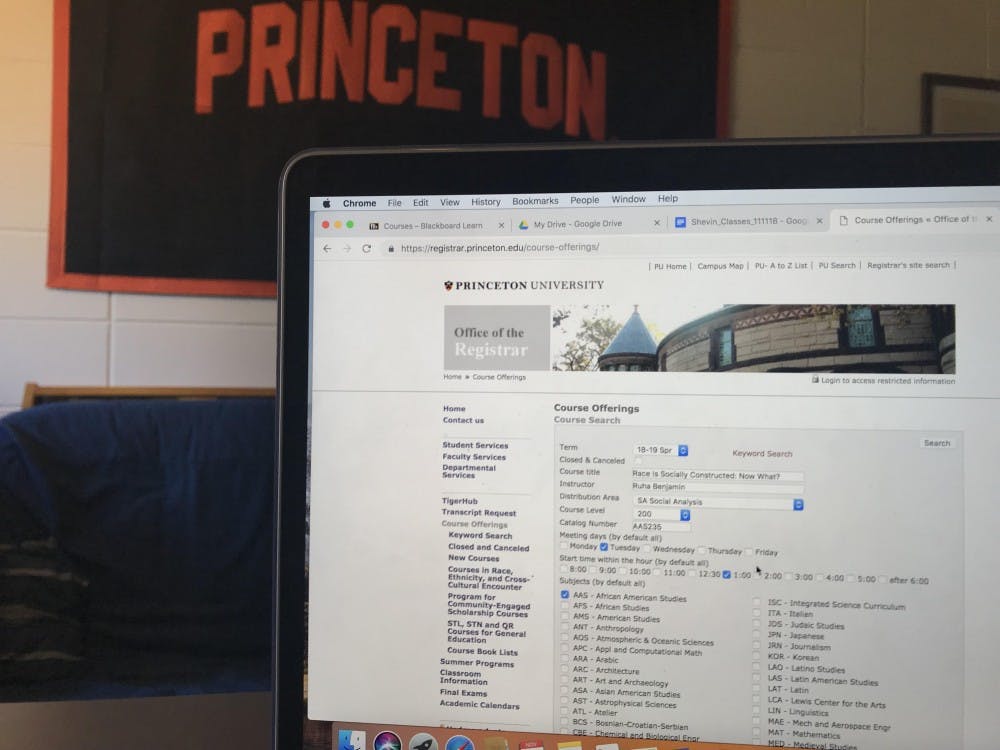Whether due to riveting subject material, applicability of content, a particularly well-known professor, or all of the above, some University classes are more widely popular than others.
The Office of the Registrar added spring semester classes to its list of course offerings on Nov. 8, giving students the opportunity to pour over the webpage while procrastinating on work for their current classes. Course selections begins Dec. 5, when seniors choose courses, and staggers with each class, ending with first-year course selection from Dec. 12 to 14.
The Daily Princetonian took a look at next semester’s offerings and talked to current and former students about three of the University’s most popular courses, from STEM, social science, and humanities fields. Here’s what they had to say:
COS 126/EGR 126: Computer Science — An Interdisciplinary Approach
University President Christopher L. Eisgruber ’83 wrote in December 2015 that when he came to the University as a student his parents insisted he take at least one computer science class. The practicality of computing and the rise of coding-based jobs have led many University students to make that same decision. That one course, for many, is COS 126.
Over half of students take COS 126 before graduation.
Professor Robert Sedgewick introduced COS 126 in 1992, and he and professor Kevin Wayne developed the course together. Sedgewick and Wayne co-wrote the course textbook, “Computer Science: An Interdisciplinary Approach.”
The professors claim the course sets out to teach basic principles of computer science in the context of scientific, engineering, and commercial applications. Students learn to program in Java, specifically.
“The applications of what you learn can really be used to show you some of the real-world applications of COS, versus sometimes in other classes where you will simply write code,” Nishaad Khedkar ’22 said. “If I was better at programming, I would be a COS major, because it’s just very cool.”
Since the fall of 2015, COS 126 has incorporated a “flipped” classroom model, with lectures completely digitized. Students attend precepts to do examples and master the material in the lectures and attend optional class meetings for further assistance.
Khedkar said that although he personally prefers learning in a classroom setting, many of his peers appreciate the flipped classroom approach.
“The video lectures are very convenient in the sense that a lot of kids speed them up to watch them, they save a lot of time, and you can do them on your own schedule. From most of the people I’ve talked to, there’s an overwhelmingly positive view,” he said.

Khedkar said he noticed a discrepancy between first-time coders and more experienced students in the class. Some more experienced students, he said, can ace the class without going to lectures or showing up to class meetings, which may discourage some first-time coders.
“It can take people from between 15 minutes and eight hours to do the assignments,” he said. “If there are people that are considering taking the course that have never programmed before, I would have them be aware that it moves very fast, but also it’s definitely very easy to do well if you’re willing to put the work in.”
During the 2016–17 school year, 637 students enrolled in COS 126. In the 2017–18 year, that number jumped to 677. This year, that number could very well rise, with 382 students taking the course in just the fall semester.
Khedkar noted that many students currently enrolled in COS 126 are engineers or computer science majors, since engineering has a computer science requirement. However, the interdisciplinary approach to computer science, he said, allows students with wide-ranging educational and professional interests to get something out of COS 126.
He also said understanding computer science and being able to code will be increasingly useful for a wide range of fields of work.
“In the future, it will probably be the most important skill to have,” he said.
This fall, Sedgewick teaches the course, and professors Alan Kaplan, Dan Leyzberg, and Jérémie Lumbroso serve as co-lead preceptors. In the spring, Leyzberg will take over teaching.
AAS 235/SOC 236: Race Is Socially Constructed — Now What?
With overwhelmingly positive reviews and a rating of 4.70 out of 5 on student course evaluations last year, Race Is Socially Constructed: Now What? has become a widely popular course. AAS 235 is only open to first-years and sophomores.
When professor Ruha Benjamin offered the course in spring 2015, 60 students enrolled. In 2016, that number grew to 93. The course was not offered in 2017, but when it returned in the spring semester of 2018, 102 students enrolled.
Masha Muira ’21 said that whenever someone asks her for a good class to take, she steers them toward AAS 235.
AAS 235, she said, touches on the history of race relations, but focuses more heavily on how that history plays out in the present day.
“You just learn the basic framework of race as it intersects with class, with gender, and with sexuality in the United States,” she said. “Personally, I really liked the class because it gave me a terminology for understanding my daily experiences. Racism wasn’t just something that I knew happened to all people. Now, I could determine it as intersectional, or interpersonal, as opposed to not knowing how to describe my experiences.”
Muira said that she was undecided between majoring in politics and African American studies until Benjamin’s class made up her mind. However, she said that the class’s students come from a wide range of academic interests, probably because the class has such a good reputation.
“I really do think it’s a class people should take,” she said. “Not just because I’m an AAS major and because I’m a black woman, but because it’s important to understand the racial framework of the United States.”
JRN 240/CWR 250: Creative Non-Fiction
One of the University’s longest running classes, Creative Non-fiction, taught by Professor John Angus McPhee ’53, will be available again this spring.
Cross-listed as JRN 240 and CWR 240, enrollment is limited to 16 students, who are chosen through application. This year, the course is only open to sophomores.
JRN 240 has a 4.93 out of 5 rating from course evaluations in spring 2018.
McPhee grew up in the town of Princeton and graduated from the University. He has written for Time magazine and The New Yorker and is the author of over 30 books. He has won a number of prestigious awards for his writing, most notably the Pulitzer Prize in 1999 for “Annals of the Former World.”
Valerie Wilson ’18, who took the course in 2016, said McPhee’s experience attending the University gives him a unique understanding of the student experience. For example, she said, McPhee only opens his class to sophomores based on his comprehensive understanding of the University’s quirks and his belief that a Princetonian’s sophomore spring is the best time for his class.
Wilson said what she appreciated most was the one-on-one attention given to students in the class.
“The conferences were the real standout thing,” she said. “You would just sit down, and he would take out your story from that week, and it would be all marked up, and he would just go through it with you, and he would talk about every single comment that he had written.”
Wilson said that McPhee would take time to discuss everything about students’ writing assignments with them, down to extreme detail. He would thoroughly explain even minute grammatical errors.
Beyond that, she appreciated the overly constructive nature of McPhee’s criticism. Wilson said that the class has made her more confident in her academic writing, which has helped her pursue freelance writing opportunities and helped in her first year pursuing a master’s degree in medieval and renaissance studies at Columbia University.
“It kind of gave me permission to pursue writing in a more serious way,” she said. “I would have never started doing creative writing if it weren’t for that class.”
As to why the class is so popular, she gives partial credit to McPhee’s extensive, well-regarded body of work and the prestigious awards that he has received. However, she thinks much of it has to do with the class’ reputation.
“The class itself has a reputation as being one of the few opportunities you really get where you get to hone in on your writing on a really granular, one-on-one level,” she said. “It’s something unique.”
Professor Joe Stephens, the director of the Program in Journalism, had nothing but positive things to say about McPhee and his class.
“Professor McPhee’s course is a national treasure, and has helped launch the careers of some of our nation’s finest writers. More importantly, John is a kind and giving person, and a generous mentor,” he wrote in an email to the Prince.
The application for JRN 240/CWR 250, which includes a writing sample submission, was due at noon on Nov. 16.
Course selection will begin with on Dec. 5, when seniors begin selecting courses, and end with first-year course selection from Dec.12–14.









